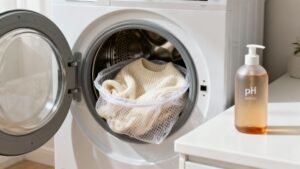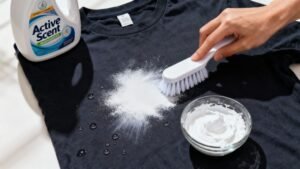
How to Soften Fabrics From Stiff to Silky
Ever pulled a favorite t-shirt from the dryer, only to find it feels disappointingly rough? Or noticed your once-fluffy towels have lost their plush, comforting texture? This isn't just normal wear and tear; it's often a sign of invisible culprits clinging to the fibers.
Let's get into the real reason your fabrics feel stiff and scratchy.
The Real Reason Your Fabrics Feel Stiff
The problem usually starts with your water. If you live in an area with hard water, it’s rich in minerals like calcium and magnesium. With every wash, these minerals leave behind tiny, invisible deposits on your clothes.
Over time, these deposits accumulate, essentially creating a microscopic layer of rock that coats every thread. This buildup is what makes the fabric rigid and scratchy to the touch, robbing it of its natural softness.
The Role of Detergent and Buildup
Another major factor is detergent residue. It’s easy to think that more soap means a better clean, but using too much can backfire. Low-quality detergents or simply an excess amount can leave behind a sticky film that doesn't fully rinse away.
This residue not only stiffens the fabric but can also trap odors—defeating the entire purpose of doing laundry in the first place.
This is exactly where a premium laundry routine makes all the difference. Active Scent's fragrance-free detergent has been carefully formulated for a deep and effective clean without competing fragrances. It’s the ultimate neutral base, created to perfectly complement our range of luxury scented fabric softeners and restore that truly soft, revitalized feel you’re looking for.
The desire for softer, better-cared-for textiles is a growing global trend. This rising consumer awareness is a key driver in the fabric care market.
It's no surprise that the global fabric softener and conditioner market was valued at USD 14.59 billion in 2023 and is projected to hit USD 18.35 billion by 2030. This growth shows just how much people value the benefits of beautifully maintained fabrics. You can dive deeper into these trends on Maximize Market Research.
To make it even clearer, here are the main culprits behind stiff laundry and how to fix them on the spot.
Common Causes of Stiff Laundry and How to Fix Them
| Problem | Cause | Quick Solution |
|---|---|---|
| Scratchy Towels & Tees | Mineral deposits from hard water are coating the fabric fibers. | Add a half-cup of white vinegar to the rinse cycle to dissolve mineral buildup. |
| Dull, Stiff Clothes | Using too much detergent or a low-quality formula is leaving residue. | Cut your detergent amount in half and ensure your machine isn't overloaded for a better rinse. |
| Over-Dried & Brittle Feel | Excessive heat in the dryer is "baking" the fibers and any remaining residue. | Tumble dry on a lower heat setting or air-dry items whenever possible. |
| General Roughness | Fabric softeners are being washed away too early or not dispersing properly. | Clean your dispenser drawer and add fabric softener only during the final rinse cycle. |
Ultimately, knowing how to soften fabrics starts with understanding why they become stiff. Once you tackle both mineral deposits and detergent buildup, you lay the groundwork for a laundry routine that doesn’t just clean—it actively restores your favorite textiles.
How to Use Your Washing Machine to Get Softer Clothes
Your washing machine can be your best ally in the quest for soft, inviting fabrics. But it’s not just about tossing clothes in and hoping for the best. The secret is making the settings work for you. A few small tweaks can completely change how your laundry feels right out of the drum.
A classic mistake? Overloading the machine. When your clothes are crammed in there, they can't move around. Detergent gets trapped, rinsing is a disaster, and you’re left with that stiff, scratchy residue we all hate.
As a rule of thumb, only fill the drum about three-quarters full. This gives everything enough room to tumble, clean, and rinse properly.
Fine-Tune Your Cycle Settings
Beyond just how much you wash, the cycle you choose is everything. The water temperature, cycle type, and spin speed all play a part in the final texture of your fabrics.
- Rethink Water Temperature: Hot water is great for killing germs, but it’s tough on fibers. Switching to warm or cool water is much gentler, helping preserve the natural softness of your clothes.
- Ease Up on the Spin: A high-speed spin cycle feels efficient, but it aggressively twists and compresses fabrics. Dial it back to a lower or medium spin speed. It’s less abrasive and leaves clothes less stiff and wrinkled.
- Always Add an Extra Rinse: If your machine has this option, use it. An extra rinse cycle is a game-changer for getting rid of every last bit of detergent residue—one of the biggest culprits behind stiff laundry.
The goal is to get a perfect clean without any lingering residue. A thorough rinse is what allows your fabric softener to work its magic directly on the fibers, not on a layer of leftover soap.
Mastering these simple adjustments transforms a regular wash into a softening treatment. This is especially true for fabrics like cotton, which can feel rough if washed incorrectly. For a deeper dive, you can learn more about how to properly wash cotton shirts to keep them feeling incredible. These little changes build the perfect foundation for any softening products you add later on.
Choosing a Softener That Creates an Experience
Knowing how to soften fabrics goes way beyond just getting a certain feel. It's about turning a chore into a sensory ritual. The right fabric softener doesn't just treat the fibers—it elevates the entire moment, leaving a lasting impression on both your textiles and your mood.
Think of it as the final, artful touch in your laundry routine. An exceptional product delivers a spark of joy, a touch of boldness, and a surge of confidence. This is where the scent composition becomes everything, turning clean clothes into an olfactory statement.
The Art of a Signature Scent
Inspired by the spirit of iconic French houses like Dior, Mugler, Chanel, and Le Labo, our fragrances are bold, mysterious, hypnotic, and unforgettable. These scents don't just tell a story, they leave a lasting impression.
Imagine your linens infused with a carefully composed story.
- Deep, earthy patchouli fuses with the burning radiance of amber.
- Fiery pimento berries ignite the composition with spice and warmth.
- Creamy tonka bean and rich guaiac wood envelop the scent in depth, while a touch of styrax adds a smoky elegance.
At Active Scent, our lead perfumer masterfully blends light and shadow, creating scents that are as enigmatic as they are energetic. Inspired by the complexity of raw materials, we use premium, ethically sourced ingredients to capture the essence of contemporary individuality.
The secret to a truly powerful scent experience is a clean slate. A luxury fragrance can only shine when it isn't competing with other smells.
This is exactly why the foundation of your wash is so critical. Pairing a luxury scented fabric softener with a powerful, odor-free laundry detergent creates the perfect synergy. Powerful cleaning. Zero interference. The detergent delivers that deep, effective clean you need but without any interfering fragrances, establishing a perfectly neutral base.
This allows the softener's meticulously crafted aroma to fully bloom, leaving your fabrics not only incredibly soft but also cloaked in a sophisticated, lasting scent. While these luxury options provide a complete sensory package, you can also explore other methods. For those interested in a more DIY approach, you can learn more about how to make homemade fabric softener as a simple alternative.
Ultimately, choosing a softener is about selecting an experience. It’s a decision to make laundry feel less like a task and more like an act of self-care.
Skip the Chemicals: Soften Your Fabrics the Natural Way
If you're looking for a softer touch without the synthetic fragrances and chemicals, your own kitchen pantry is the perfect place to start. Some of the most effective fabric softeners are simple, everyday staples that work wonders on stiff, scratchy clothes.
Distilled white vinegar is a game-changer. Just pour a half-cup into your machine’s rinse cycle. It acts as a natural clarifier, dissolving the mineral deposits and detergent residue that make fabrics feel rough.
And don't worry—the vinegar smell vanishes completely as your laundry dries, leaving behind nothing but pure softness. It’s my go-to trick for bringing stiff towels back to life.
Elevate Your Wash and Dry
Baking soda is another hero, especially if you have hard water. Add a half-cup right into the wash drum with your clothes. It balances the water’s pH, which softens it and actually makes your detergent more effective.
This little boost helps your detergent rinse away cleanly, so there’s no stiffening residue left behind. It’s a simple move that delivers a one-two punch of cleaning and softening.
The real secret to these natural methods? They aren't coating your fabrics; they're stripping away the buildup. By removing mineral deposits and soap scum, you’re revealing the fabric's original, intended softness.
The natural approach doesn’t have to stop at the washer. When it's time to dry, swap out your single-use dryer sheets for wool dryer balls.
- How They Work: As they tumble around, the wool balls separate your clothes, letting warm air flow more freely. This not only fluffs everything up but also cuts down on drying time.
- The Softening Secret: The gentle friction from the wool naturally softens fibers without any chemicals or coatings.
- Static-Free Finish: They also fight static cling, making them a brilliant eco-friendly and reusable alternative to traditional sheets.
With these simple pantry staples, you can master the art of softening fabrics naturally, using items you already have on hand. It's a small detail that makes a world of difference.
A Practical Guide to Softening Different Fabrics
Not all fabrics are created equal, and the secret to incredible softness is knowing how to treat each one. A trick that works wonders on sturdy cotton could be a disaster for delicate silk. This is about tailoring your approach so every item in your closet, from rugged denim to plush towels, gets the exact care it deserves.
Let’s talk towels. Their biggest enemy is that waxy buildup from traditional softeners, which coats the fibers and kills their absorbency. To get that five-star hotel fluffiness back, skip the softener entirely and pour one cup of white vinegar into the rinse cycle. This simple move strips away all that gunk, leaving your towels unbelievably soft and thirsty again.
Breaking In Denim And Caring For Delicates
That new pair of rigid jeans can feel like cardboard. To break them in without losing that perfect dark wash, turn them inside out and wash them on a gentle cycle with a half-cup of salt. It’s an old-school trick that works by softening the stiff cotton fibers while locking in that deep indigo dye.
When it comes to delicate materials like wool or silk, a gentle touch is everything. Always, always use a pH-neutral detergent and cool water. Instead of a commercial softener, try adding a few drops of your own hair conditioner to a basin of water for the final rinse. It conditions natural fibers just like it does hair—a total game-changer, especially when you're figuring out how to wash designer clothes and need to protect their integrity.
The key is to work with the fabric's natural properties, not against them. Real softness often comes from removing what's been added—like mineral buildup or product residue—and letting the fibers finally breathe.
To make things even easier, here’s a quick cheat sheet for getting the best results with your laundry.
Fabric Softening Cheat Sheet
This quick-reference guide shows you the best (and worst) ways to soften some of the most common fabrics you'll find in your home.
| Fabric Type | Best Method | Method to Avoid |
|---|---|---|
| Cotton & Towels | White Vinegar (1 cup in rinse cycle) | Traditional Liquid Softener |
| Denim | Salt (1/2 cup in wash cycle) | High Heat Drying |
| Wool & Silk | Hair Conditioner (a few drops in rinse) | Harsh Detergents, Agitation |
| Synthetics | Dryer Balls or DIY Softener Spray | Overuse of Softener Sheets |
Stick to these guidelines, and you’ll notice a real difference in how your clothes and linens feel.
The Growing Demand for Fabric Care
It’s clear people are paying more attention to how they care for their fabrics, and the market shows it. The global fabric softener sheet market was valued at USD 21.37 billion in 2024 and is projected to hit USD 32.84 billion by 2034. This boom is all about the demand for better, more innovative formulas that are both sustainable and gentle on the skin. If you’re interested in the numbers, you can dive deeper into these market trends over at Precedence Research.
Your Top Fabric Softening Questions, Answered
Even laundry pros run into snags. You’ve followed all the steps, but something’s just not right. It happens. Perfecting the art of laundry is a process, so let’s walk through some of the most common questions and get you that silky, luxurious feel every single time.
A big one we hear all the time: can you use too much fabric softener? Absolutely, yes. More is definitely not better here. Overdoing it creates a waxy buildup on your clothes, which is the last thing you want. It makes towels less absorbent and can even gunk up your washing machine. Always, always stick to the recommended amount on the label.
Why Is My Softener Not Working?
If your clothes are coming out stiff even after using a quality softener, the number one suspect is hard water. Those high mineral deposits create a roughness that even the best softeners can't fight on their own. The easy fix? Add a water-softening agent like baking soda to your wash cycle. It’s a game-changer.
Another culprit could be leftover detergent. This happens if you use a little too much soap or stuff your machine too full. Make sure you’re measuring your detergent correctly, and if you suspect residue, just run an extra rinse cycle.
The goal is always a perfect clean that leaves fibers receptive to conditioning. A thorough rinse ensures that your luxury softener can work directly on the fabric, not on a layer of old soap or mineral deposits.
Liquid Softeners vs. Dryer Sheets
People often wonder which is better, and the truth is, they do different things.
- Liquid Softeners: These get to work during the rinse cycle, conditioning and lubricating fibers from the inside out. This is what delivers that deep, lasting softness you can really feel.
- Dryer Sheets: These are activated by the heat in your dryer. They leave a light coating on fabrics to cut down on static and add a quick hit of fragrance.
For that intense, all-over softness and a truly luxurious feel, a high-quality liquid softener is your best bet. But for convenience and static control, dryer sheets have their place. Of course, a long-lasting, beautiful aroma is key. You can find more tips on how to keep clothes smelling fresh to elevate your whole routine.
How Do I Soften Brand New Towels?
You know that stiff, almost waxy coating on new towels? It’s a factory finish that makes them look great on the shelf but feel terrible on your skin. Before you use them, they need a little prep work.
Wash them in warm water with one cup of white vinegar—no detergent needed for this step. Then, run a second cycle with a half-cup of baking soda, again, no detergent. This one-two punch strips away that coating and fluffs up the fibers beautifully, making them soft and absorbent from the very first use.
LAUNDRY NEVER SMELLED SO GOOD! Ready to transform your laundry into a sensory experience? Active Scent fuses powerful detergents with luxurious fragrances inspired by iconic perfume houses. Discover the art of laundry at https://active-scent.com.










